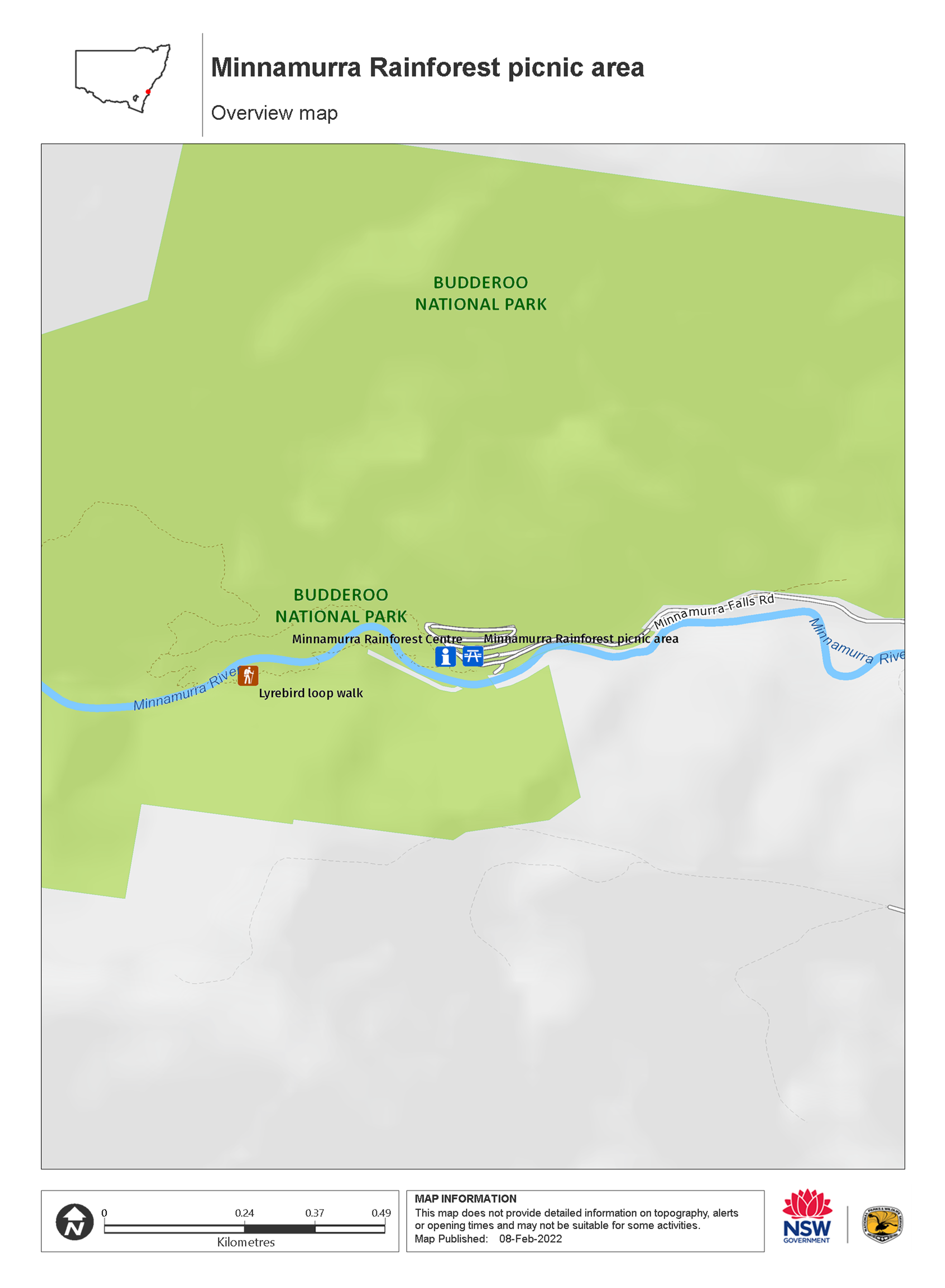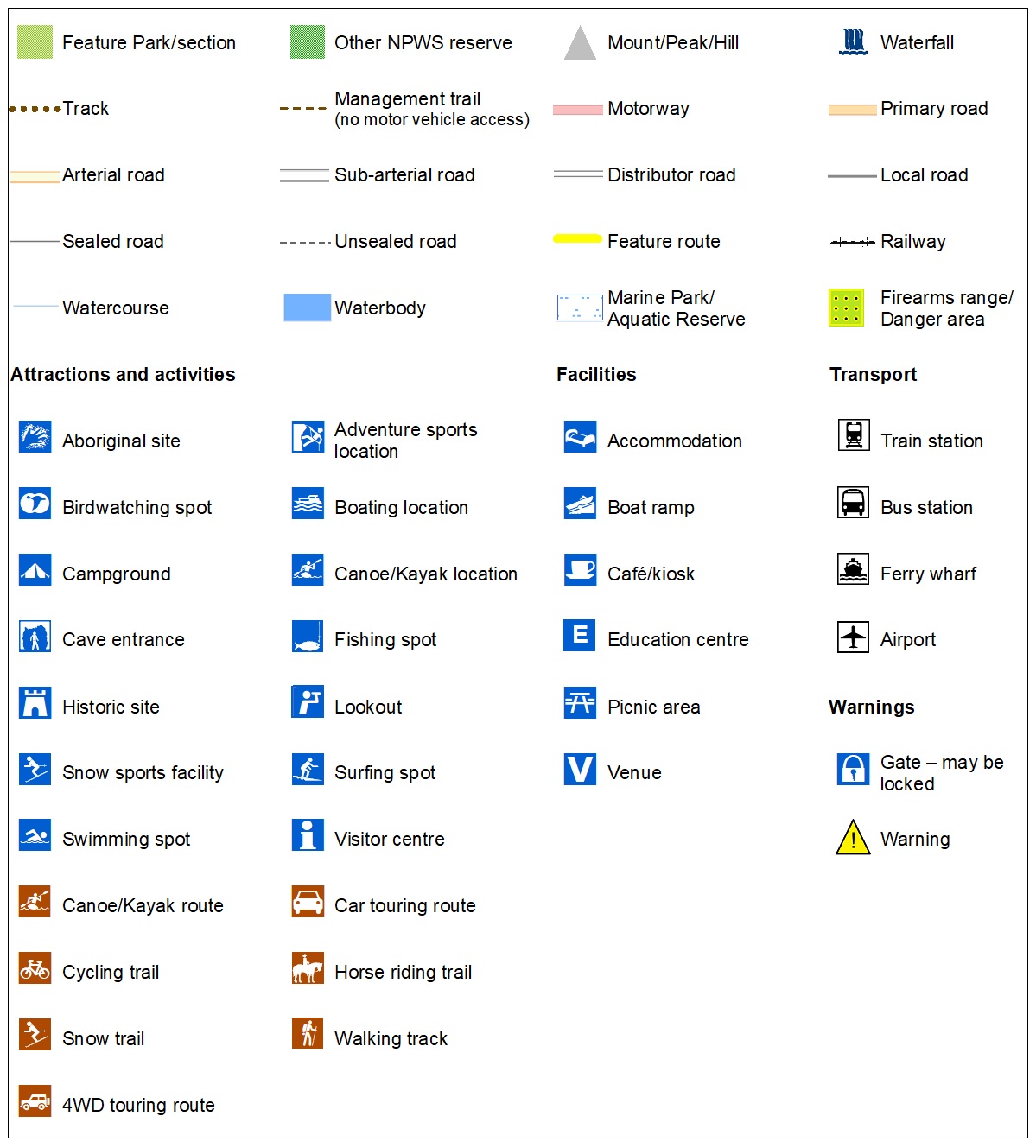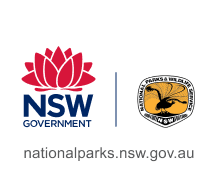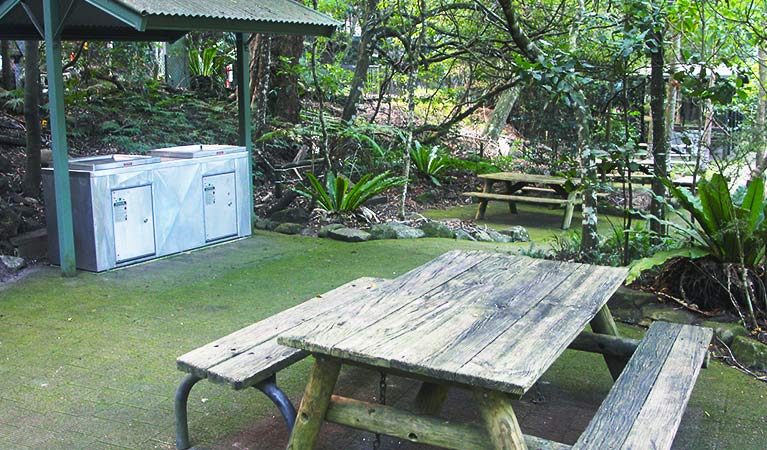Overview
Minnamurra Rainforest picnic area is in Budderoo National Park, near Kiama. This peaceful riverside spot is the perfect place to stop for lunch when you explore Minnamurra Rainforest.
Nearby
-

Minnamurra Falls walk
Starting at the Minnamurra Rainforest Centre, enjoy spectacular rainforest, waterfall and canyon views from several viewing platforms along Minnamurra Falls walk.
-

Lyrebird loop walk
Ideal for walking with children, the beautiful Lyrebird loop walk takes an hour to complete. It’s located within Minnamurra Rainforest Centre in Budderoo National Park.
-

Minnamurra Rainforest Centre
Visit Minnamurra Rainforest Centre in Budderoo National Park and chat to the friendly staff before exploring the rainforest along raised boardwalks.
-

Minnamurra Rainforest self-guided audio tours
Immerse yourself in the sounds, plants, birdlife and history of Minnamurra Rainforest with this series of self-guided audio tours. Download and enjoy as you stroll along Lyrebird loop walk.
These maps give a basic overview of park attractions and facilities, and may not be detailed enough for some activities. We recommend that you buy a topographic map before you go exploring.
Map

Map legend

Local alerts
For the latest updates on fires, closures and other alerts in this area, see https://www.nationalparks.nsw.gov.au/things-to-do/picnic-areas/minnamurra-rainforest-picnic-area/local-alerts
General enquiries
- National Parks Contact Centre
- 7am to 7pm daily
- 1300 072 757 (13000 PARKS) for the cost of a local call within Australia excluding mobiles
- parks.info@environment.nsw.gov.au
Park info
- in Budderoo National Park in the South Coast and Country NSW regions
Budderoo National Park is always open but may have to close at times due to poor weather or fire danger. The park gates at Minnamurra Rainforest Centre open at 9am and close at 5pm every day.
-
Park entry fees:
$12 per vehicle per day only in the Minnamurra Rainforest area. Bus or taxi: $4.40 per adult and $2.20 per child.
Buy annual pass.
Visitor info
All the practical information you need to know about the Minnamurra Rainforest picnic area.
Maps and downloads
Visitor centre
-
Minnamurra Rainforest Centre
345 Minnamurra Falls Road, Jamberoo NSW 2533 - 9am to 4pm daily. Closed Christmas Day.
- 02 4236 0469
Learn more
Minnamurra Rainforest picnic area is in Budderoo National Park. Here are just some of the reasons why this park is special:
A splash of relaxation

Nurtured and conserved for over a century, the Minnamurra Rainforest is exceptionally precious. At this much-loved tourism destination, you can wander raised boardwalks and explore the rainforest that once blanketed much of the region. For the ultimate experience, combine the Lyrebird loop walk and Minnamurra Falls walk and discover exquisite plants and animals in breathtaking surroundings. If you’ve ever fallen asleep to the sounds of a relaxation CD, you’ll know the peaceful power of waterfalls. And with its own wonderful falls, Budderoo might just be one of the most relaxing places around. Walk to Minnamurra Falls, an amazing double-tiered waterfall, or Carrington Falls, with its fabulous 50m drop. Sit back, listen to the hypnotic sound of flowing water and let your cares drift away.
- Carrington Falls picnic area Be wowed by Carrington Falls from one of three lookouts with great views. You’ll find picnic and barbecue facilities close by along with some short walking tracks.
- Carrington Falls walking track Discover fantastic waterfall views on the short Carrington Falls walking track, in Budderoo National Park, near Robertson. It’s a great day trip for families and nature lovers in the Southern Highlands.
- Friends of Minnamurra Rainforest You don’t have to be a weeding specialist to get involved in volunteer work at Minnamurra Rainforest. Join local experts and like-minded volunteers for bush regeneration in Budderoo National Park.
- Jamberoo lookout Enjoy spectacular scenic views of Kiama and Lake Illawarra from Budderoo National Park’s Jamberoo lookout. On clear days, this lookout is fantastic for photography.
- Minnamurra Rainforest Centre Visit Minnamurra Rainforest Centre in Budderoo National Park and chat to the friendly staff before exploring the rainforest along raised boardwalks.
Park life

You're almost guaranteed to see wildlife in the park, particularly if you visit Minnamurra Rainforest Centre. Look for bowerbirds and king parrots, and visit between June and August for the spectacular image of a male lyrebird displaying his tail. You've a good chance of spotting a swamp wallaby at dawn or dusk, and keep an eye out for an eastern water dragon or perhaps even a diamond python soaking up the sunshine.
- Birds of Minnamurra self-guided audio tour Take a self-guided audio tour along Lyrebird loop walk with fauna ecologist David Bain and discover some of the fascinating birds that live in Minnamurra Rainforest. See if you can spot the ones that David points out as you explore the incredible subtropical rainforest of Budderoo National Park.
- Investigating the living world: Minnamurra Join us as we explore living things on this Stage 3 (Years 5 to 6) Science and technology excursion. Students will investigate and analyse the natural environment of Minnamurra Rainforest, Budderoo National Park.
- Junior ranger: Minnamurra Rainforest Become a ‘junior ranger’ these school holidays at Minnamurra Rainforest. You’ll learn hands-on bush survival and safety skills on this fun tour at Budderoo National Park.
- Life in the rainforest: Minnamurra Rainforest Join us as we explore life in the rainforest on this Stage 2 (Years 3-4) Science and Technology excursion at Minnamurra Rainforest. Students will carry out investigations to explore the living world in this beautiful part of Budderoo National Park.
- Living world: Minnamurra Rainforest Explore the Living World with us on this Stage 1 (Years 1-2) Science and Technology at Minnamurra Rainforest in the Budderoo National Park. Students will explore the rainforest environments and learn the importance of plant and animal habitat.
Walk through history

A walk around the park reveals its many uses over the years. Spot remaining cedar trees, so prized by foresters in the 1800s. Head downstream from the Minnamurra Rainforest to see the 1853 Kelly's Cottage and its camellia tree, believed to be one of the southern hemisphere's oldest. The land's rich soil and water supply make it ideal for dairy farming, and you can still see the monument to Australia's first butter factory in nearby Jamberoo Valley.
Plants and animals protected in this park
Animals
-

Spotted-tailed quoll (Dasyurus maculatus)
The spotted-tailed quoll is the largest remaining carnivorous marsupial on the Australian mainland. It’s protected as a vulnerable species in NSW.
-

Eastern ground parrot (Pezoporus wallicus wallicus)
The eastern ground parrot is a beautiful, ground-dwelling native bird that lives in low heathland habitat along the NSW North and South coasts and escarpments. It’s listed as a vulnerable species in NSW.
-

Platypus (Ornithorhynchus anatinus)
One of the most fascinating and unusual Australian animals, the duck-billed platypus, along with the echidna, are the only known monotremes, or egg-laying mammals, in existence. The platypus is generally found in permanent river systems and lakes in southern and eastern NSW and east and west of the Great Dividing Range.
-

Superb fairy wren (Malurus cyaneus)
The striking blue and black plumage of the adult male superb fairy wren makes for colourful bird watching across south-eastern Australia. The sociable superb fairy wrens, or blue wrens, are Australian birds living in groups consisting of a dominant male, mouse-brown female ‘jenny wrens’ and several tawny-brown juveniles.
Plants
-

Cabbage palm (Livistona australis)
With glossy green leaves spanning 3-4m in length and a trunk reaching a height of up to 30m, the cabbage tree palm, or fan palm, is one of the tallest Australian native plants. Thriving in rainforest margins along the east coast of NSW, in summer this giant palm produces striking spikes of cream flowers which resemble cabbages.
-

Old man banksia (Banksia serrata)
Hardy Australian native plants, old man banksias can be found along the coast, and in the dry sclerophyll forests and sandstone mountain ranges of NSW. With roughened bark and gnarled limbs, they produce a distinctive cylindrical yellow-green banksia flower which blossoms from summer to early autumn.
-

Coachwood (Ceratopetalum apetalum)
Coachwood trees are Australian native plants that grow in warm temperate rainforests along coastal NSW. Also known as scented satinwood, the mottled grey bark of the coachwood has horizontal markings and a delicate fragrance.
Environments in this park
School excursions (14)
- Earth's natural systems at Minnamurra Rainforest, Stage 6 (Years 11-12), Geography
- Factors that shape places at Minnamurra Rainforest, Stage 3 (Years 5-6), Geography
- Landscapes and landforms at Minnamurra Rainforest, Stage 4 (Years 7-8), Geography
- A dynamic ecosystem: Minnamurra Rainforest, Stage 6 (Years 11-12), Biology
- Environmental change and management at Minnamurra, Stage 5 (Years 9-10), Geography
- Exploring the rainforest: Minnamurra Rainforest Centre, Stage 1 (Years 1-2), Geography
- Rainforest ecosystems - Minnamurra , Stage 5 (Years 9-10), Science
- The Minnamurra Rainforest ecosystem, Stage 6 (Years 11-12), Geography
- Protecting a rainforest environment: Minnamurra, Stage 2 (Years 3-4), Geography
- Investigating the living world: Minnamurra, Stage 3 (Years 5-6), Science and Technology
- Life in the rainforest: Minnamurra Rainforest, Stage 2 (Years 3-4), Science and Technology
- Living world: Minnamurra Rainforest, Stage 1 (Years 1-2), Science and Technology
- Survival in the rainforest: Minnamurra, Stage 4 (Years 7-8), Science
- Sustainable biomes at Minnamurra Rainforest, Stage 5 (Years 9-10), Geography

